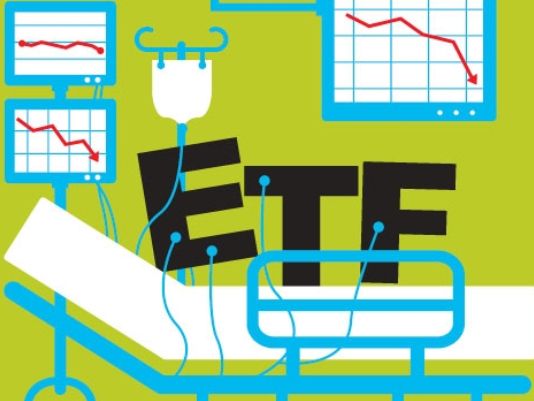Dangers of income-stretching for ETF investors
ETFs tracking utilities, mortgage-related real estate stocks and other trendy high-yield sectors have been decimated this month on surging interest rates, reminding investors of the dangers of stretching for income in a low-rate market for bonds.
Yields on the 10-year Treasury note have spiked from about 1.6% in early May to roughly 2.2% this week. Investors have been warned for years to prepare for higher interest rates but the speed of the recent move caught many of them off guard.
Safe-haven Treasury ETFs that move in the opposite direction of yields have felt the pain, especially those that focus on long-term bonds. PIMCO 25+ Year Zero Coupon U.S. Treasury Index (ticker symbol: ZROZ), Vanguard Extended Duration Treasury Index (EDV) and iShares 20+ Year Treasury Bond Fund (TLT) are all down more than 7% in May.
A combination of factors has driven Treasury yields higher as the economy improves, stocks continue to rally and investors realize the Federal Reserve is considering tapering its stimulative policies. Fed Chairman Ben Bernanke recently said the central bank could scale back its bond purchases soon if the economic and employment data justify such a move. He also indicated the Fed is keeping a close eye on investors "reaching for yield" and other forms of excessive risk-taking in a low-rate environment.
Utilities
In the stock market, the fallout from higher interest rates is most visible in utilities ETFs such as SPDR Utilities Select Sector SPDR (XLU), Vanguard Utilities (VPU) and iShares U.S. Utilities. For example, among the nine major U.S. sector ETFs managed by State Street, only XLU is in the red for May with a loss of 8%.
The utilities ETF is trailing the S&P 500 by nearly 12 percentage points for the period, a huge deficit. The underperformance is even more striking because the fund was a market leader during the first four months of 2013 as investors favored defensive, dividend-paying sectors such as utilities and consumer staples.
Investors appear to be rotating away from a utilities sector that has been bid up to expensive valuations after a strong run, and is highly sensitive to rising interest rates.
"Falling interest rates have benefited the fund's holdings over the past few years, but this tailwind is unlikely to continue because interest rates have little if any room left to fall. Since 2009, valuations for XLU's holdings have also become less attractive," says Morningstar ETF analyst Robert Goldsborough in a profile of the utilities fund.
Real estate and mortgage REITs
The rising-rates trade also has hammered real estate ETFs and mortgage REITs in particular.
The iShares Mortgage REIT Capped (REM) and Market Vectors Mortgage REIT Income (MORT) are the two worst-performing unleveraged ETFs the past month with declines of 12%.
The mortgage REIT ETFs have attracted income-starved investors — REM has a 12-month yield of more than 11% — who are now getting a harsh lesson on why higher yields come with higher risks.
Mortgage REITs are companies that typically borrow to invest in mortgage-backed securities. The leveraged companies earn profits from the spread between short-term borrowing rates and the income from the mortgage backed securities they buy.
Mortgage REITs have benefited from the Fed keeping short-term rates near zero but investors are clearly worried that rises could rise further and punish these companies.
Emerging market bonds
Another asset class that has reaped the rewards of ultra-low interest rates from central banks is emerging market bonds.
"The emerging-markets debt space has become increasingly popular in recent years," notes Morningstar analyst Timothy Strauts. "Excellent returns over the last decade and growing distrust of developed-market sovereigns have combined to increase the appeal of emerging-markets bonds."
The largest ETFs for emerging market debt include iShares JPMorgan USD Emerging Markets Bond Fund (EMB), PowerShares Emerging Markets Sovereign Debt Portfolio (PCY), WisdomTree Emerging Markets Local Debt (ELD), Market Vectors Emerging Markets Local Currency Bond (EMLC) and SPDR Barclays Capital Emerging Markets Local Bond (EBND).
Yet all the funds have suffered losses of at least 5% the past month.
Investors have boosted their allocation to emerging market bonds the past few years, and ETFs have been a popular vehicle for this trade.
The rationale is that emerging countries offer lower debt levels, higher growth and better demographics than the U.S., Europe and other developed markets. Also, liquidity and transparency has improved in these developing economies, reducing the risk of investing in their bond markets.
However, there are fears that investors' insatiable hunger for yield has created a bubble in emerging market debt.
"Over the past 12 months, $26 billion in new money flowed into mutual funds and ETFs which invest in emerging-markets debt," said Morningstar's Stauts. "This amounts to 68% of the total assets in these funds as of the beginning of this period. This is tremendous growth for such a small sector of the fixed-income market."
If interest rates rise in the U.S., emerging market bonds become less attractive because of their higher risk relative to Treasury bonds, he added.










